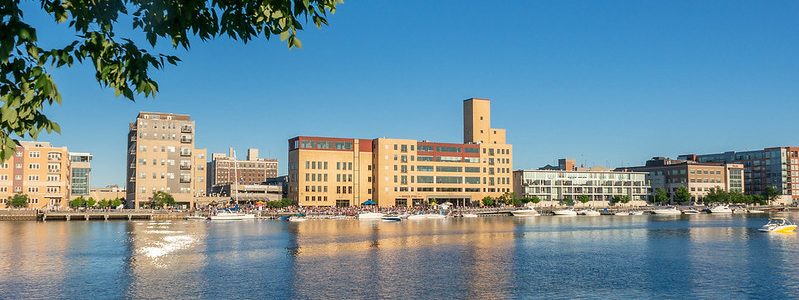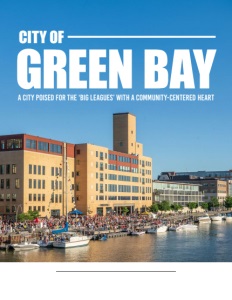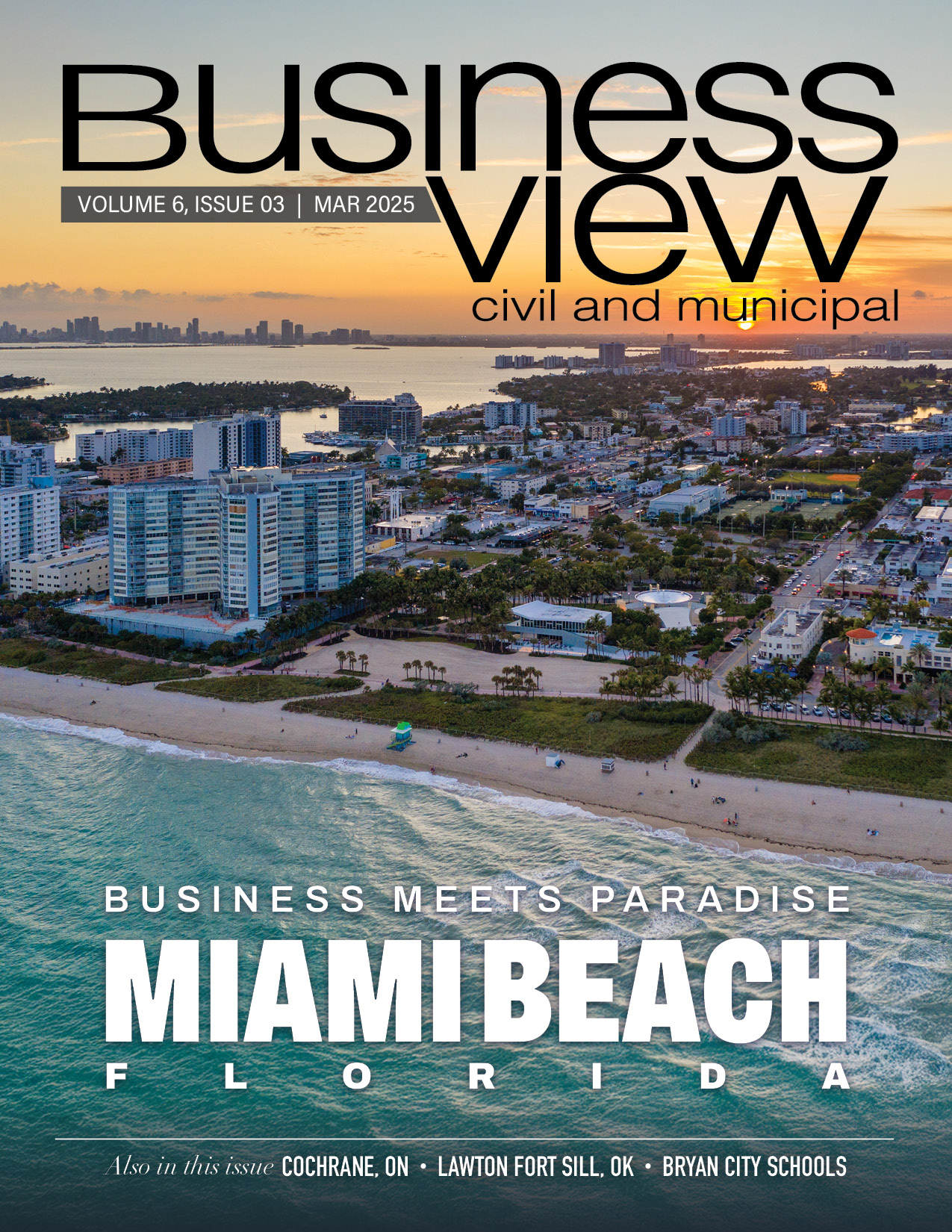A City Poised for the ‘Big Leagues’ with a Community-Centered Heart
How a mid-sized Midwest city is transforming its industrial heritage into a new era of sustainable growth and community-centered development.
Green Bay might be a city of just 110,000 residents, but it holds a distinction that catches attention nationwide. “We’re pretty unique because we have an NFL franchise team,” says Matthew Buchanan, Deputy Development Director. This modest-sized Midwestern city carries significant industrial muscle, powered by a rich manufacturing legacy and prime positioning on the Great Lakes.
The city’s economic backbone rests on its strategic location along the Fox River and Lake Michigan, where it has cultivated a thriving paper industry for generations. “Food manufacturing is also one of our primary industries,” Buchanan notes, highlighting the city’s diversified industrial base. While maintaining its blue-collar roots, Green Bay has invested heavily in enhancing its natural assets, particularly through an extensive cleanup of the Fox River – transforming what was once a polluted waterway into a prized environmental resource.
The city’s appeal extends well beyond its industrial strengths and environmental revival. Economic Development Specialist Rebecca Finco points to a remarkable achievement: “We were ranked the number one Best Place to Live in America according to US World News in 2023.” This recognition stems largely from the city’s exceptional affordability, combined with its impressive array of outdoor recreation options, extensive park systems, and thriving wildlife habitats along the shoreline.
Tale of Two Riverfronts: Downtown’s Renaissance
Green Bay’s downtown revival centers on the Fox River, which splits the district into two distinct yet complementary areas. “We have an east side downtown on the east side of the water, and then our Broadway district is on the west side,” explains Buchanan. “With the Superfund cleanup of that river, it’s really transformed our downtown making that a destination.”
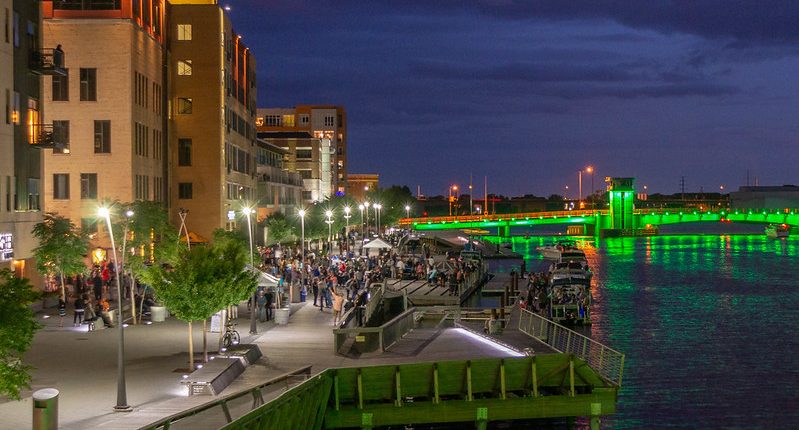
The transformation gained momentum in 2012. “The city invested in our city deck, which is this great public space, really a downtown boardwalk along the Fox,” Buchanan says. “Opening that space up for public access to enjoy the water created a tremendous real estate opportunity.” The impact was immediate, spurring redevelopment of riverfront properties and attracting significant private investment, including the replacement of a struggling downtown mall with Schreiber’s new headquarters.
In her role as Economic Development Specialist, Finco brings a unique perspective as both a professional and returning resident. “I have the perspective of somebody who was familiar with the downtown area as a child when I would come with my parents to shop at the mall,” she reflects. “To see the transformation of the downtown from what I remember from my childhood till now is really transformational. The city deck is amazing, especially in the summertime with Friday night events that attract thousands of people for live music, entertainment, and great food.”
The district’s success relies heavily on two Business Improvement Districts (BIDs): On Broadway and Downtown Green Bay. “They have their own staff dedicated to the betterment of respective areas,” Finco explains, “assisting with businesses, putting on annual events, the impression by the physical environment of those areas.” The momentum continues with new developments, including a $70 million mixed-use project by New Land featuring 268 housing units and ground-floor commercial space – the largest single private investment in the downtown’s history.
The JBS Initiative: Innovative Housing Solutions
A groundbreaking partnership between the city and international meat packing company JBS is reshaping Green Bay’s housing landscape. “A couple years ago, JBS had about 25 acres of land that they weren’t using,” explains Buchanan. “They recognized that with their own operations, they had a serious employment issue where they had a hard time building their workforce up because the housing in our community was just so limited.”
The solution emerged through an innovative collaboration. “They donated this land to us, 25 acres as well as a half million-dollar grant,” Buchanan says. “We worked with an engineering consultant, worked very closely with the neighborhood that exists in that area today and other stakeholders to put together this plan to build a brand-new neighborhood.” The comprehensive development will include a park, new roads, and infrastructure, creating a foundation for diverse housing options.
The project will address housing accessibility through multiple approaches. “We’re going to have single family homes, multifamily homes, multi-generational town homes – a myriad of options and different price points,” Buchanan notes. A particularly innovative element involves establishing a community land trust for single-family parcels. “The land trust would help make sure that the house that’s built on it is kept affordable in perpetuity,” he explains. “The people that own the house on top of the land would be able to buy that house for an affordable rate.”
The city is taking calculated risks to ensure the project’s success. “We are investing in all that infrastructure upfront,” Buchanan acknowledges, “and we’re hopeful that the development that comes after, which we expect to be getting started later this year, will help us eventually cover the cost of that infrastructure. We understand that it’s a little bit of a risk, but we have to make these kinds of investment in order to move the needle on the housing issue.”
Shipyard Development: From Brownfield to Community Asset
A former industrial brownfield along Green Bay’s South Broadway area is being reimagined as a vibrant community space. “The Shipyard development project is creating that sense of place from a piece of property that’s been remediated and is currently in the process of becoming a parkland,” explains Finco. “It’s right on the river, so there’s an opportunity there for recreation. There will be a riverfront promenade, kayak launch, fishing pier, urban beach, and a large space for gathering, concerts, and community events.”
The project represents more than just park development. “We’re taking that area and creating a state-of-the-art park that will be adjacent to some additional housing development,” Finco says. “It’ll really help to tie that entire area together, tying into the river frontage, the Shipyard Park, and then into the neighboring residential and commercial districts as well.” Future plans include an innovative container park featuring retail opportunities and a business incubator.
“That site in particular is the catalyst, but the whole corridor of South Broadway is a target for redevelopment, and we are working with the EPA on this,” says Buchanan. “It’s Brownfield central, old industrial properties that have shut down. We’ve got single family neighborhoods down here that are our lowest income census tract, and there just hasn’t been a lot of love and attention to this neighborhood for quite some time.”
The initiative has already gained significant momentum and funding. “We just wrapped up phase one of the Shipyard project, including the riverfront infrastructure and parkland,” Buchanan notes. “We received a $5 million grant from US National Park Service for phase two, so that’ll be a $10 million investment.” The comprehensive approach includes support for existing residents: “We’re working with the neighborhoods, providing grants and loans to existing homeowners and business owners. It’s a neighborhood revitalization effort to take these brownfield properties and give them a boost.”
Community-First Planning: A Collaborative Approach
For Green Bay’s planners, successful development hinges on deep community engagement. “Just how essential it is to plan with the community, to really get to know the people that are living and working in your neighborhoods,” reflects Buchanan. “I think we will be so much more successful bringing these projects to fruition, to realizing our grand plan if we do it with those neighborhood association presidents and the Chamber of Commerce and our partners with the business improvement districts.”
Personal connection to the community drives this philosophy forward. “Moving to the area has been enlightening by experiencing everything that this community has to offer,” says Finco. “I’ve had the pleasure of meeting incredible people who have been incredibly welcoming. I’ve also taken full advantage of the cultural and recreational opportunities here, discovering some of the community’s best hidden gems—from fantastic local shops and restaurants to parks and hiking trails.”
The collaborative approach has revealed the depth of local investment in Green Bay’s future. “When I first started this position, I was honestly amazed at how much was going on and how much care and attention is being put into creating a community for the betterment of all of its citizens,” Finco notes. Her perspective as a newcomer highlights the community’s welcoming nature and commitment to growth.
Buchanan emphasizes that this inclusive approach yields better outcomes. “There’s so many different players that have a role to play, and it’s just a tremendous wealth of knowledge that we can draw from,” he explains. “We’ll be so much more successful doing the good work we’re doing when we’re working closely with the people that live and work here. Not to do anything in a vacuum but bring everyone along because we all care so much about our community.”
Future Priorities: Green Bay’s Growth Strategy
Green Bay stands at the cusp of significant expansion, with several strategic developments poised to reshape the city’s future. “We have some land opening up within our community, some within the downtown, some on the outskirts that I think will really enable us to take a giant step forward in our overall growth and economic vitality,” says Finco. These developments represent crucial pieces in the city’s comprehensive growth strategy.
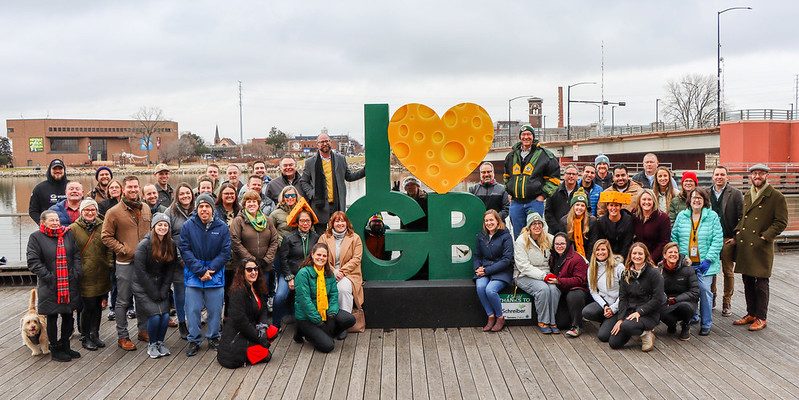
A key partnership with the local university promises to boost innovation and talent retention. “We’ve got this tremendous partnership with the University of Wisconsin Green Bay, where they are looking to build a Phoenix Innovation Park,” Finco explains. The initiative will strengthen the connection between education and industry. Buchanan elaborates: “That’ll do so much with helping build a pipeline for talent, with building that bridge between the people in our community who are studying, who are learning, who are young, and helping them jump right to a great position that’s focused on research.”
Housing remains another central focus of the city’s development plans. “We’ll be seeing the JBS project through in the next couple of years,” Buchanan notes. “We have a lot of new housing that should be wrapping up, so I’m hopeful we’ll be in a better position with solving our housing crisis.” This multi-pronged approach to housing development demonstrates the city’s efforts to address one of its most pressing challenges.

The combination of academic innovation, housing solutions, and strategic land development positions Green Bay for sustainable growth. “Having that research park here locally, it’ll do wonders for us,” Buchanan predicts. These initiatives, coupled with the ongoing downtown renaissance and community revitalization projects, create a comprehensive framework for Green Bay’s evolution from a traditional industrial city to a diverse, forward-looking urban center that maintains its unique character and affordability.
At a Glance
Who: City of Green Bay
What: A mid-sized city undergoing major transformation through strategic development initiatives, including downtown revitalization, innovative housing projects, and brownfield redevelopment.
Where: Wisconsin
PREFERRED VENDORS/PARTNERS
Established in 1882, the Greater Green Bay Chamber exists to build a greater Green Bay by helping businesses succeed. Our mission is to strengthen member businesses by enhancing economic and workforce development, resulting in improved quality of life in our community and region.
Greater Green Bay Chamber: www.greatergbc.org
